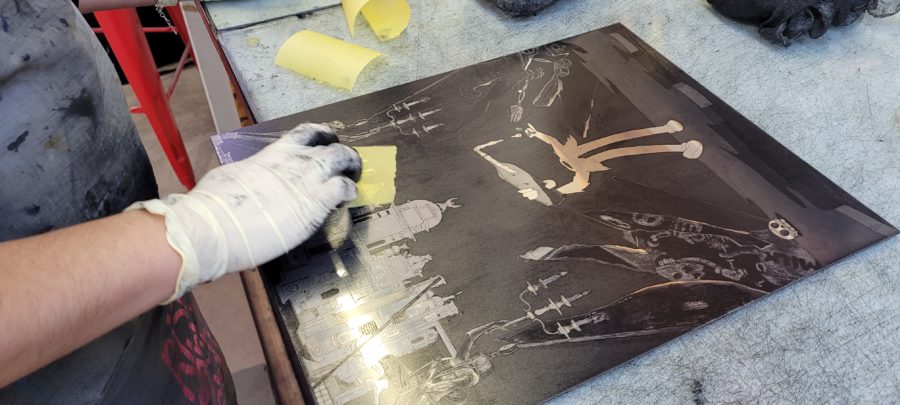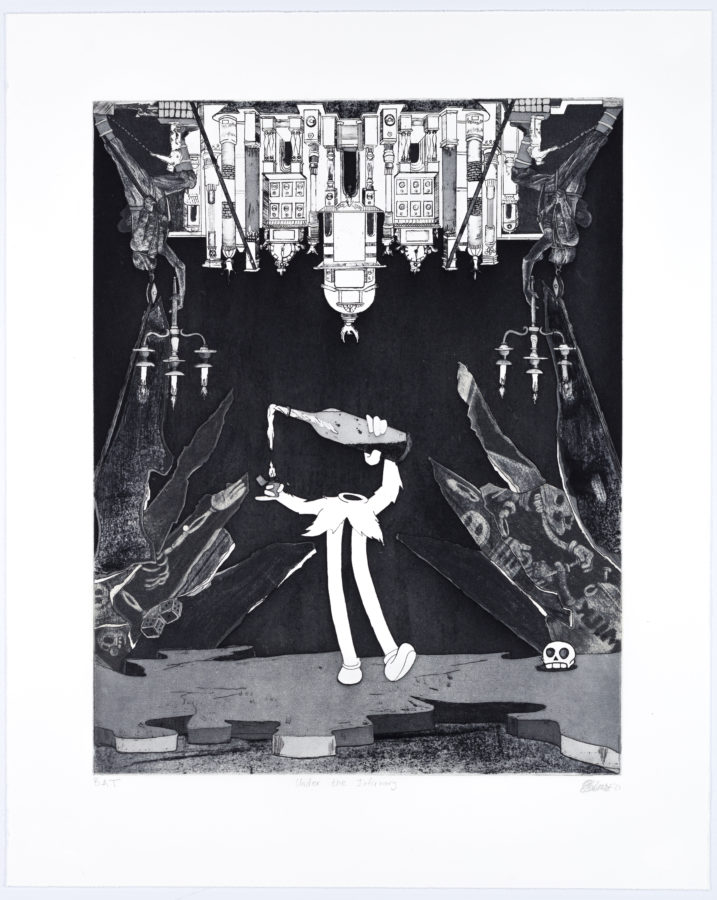Text by Christa Swanepoel
We are proud to present artist Chad Cordeiro’s new print called Under the Infirmary as our selection for print of the month for March 2022. Kim-Lee Loggenberg was the editioning printer for this work.
Chad Cordeiro is well known at the David Krut Workshop (DKW), having joined the David Krut Bookstore in 2012 and then joined the DKW as a printer the following year. 2022 marks the tenth year Cordeiro has been a part of DKW, thus we are very pleased that this print, as well as the rest of his body of work titled Notes from the infirmary, was created by Cordeiro as an artist in collaboration with DKW. Cordeiro has collaborated with DKW as an artist previously; in 2016 Cordeiro, together with artist-printmaker Nathaniel Sheppard, held their first exhibition called Kwaal-ity Control which played a role in Cordeiro’s relationship with printmaking and the imagery he uses in his works. Drawing from film, music, and image, Cordeiro uses fragments of contextually disparate media to create a series of collages, etchings, and linocut prints which exist as a response to multiple, inter-connected narratives that are ubiquitous in media archives and collections.
Cordeiro is an experienced and passionate print technician as well as artist, so it is no wonder that the process of printmaking informs his work as an artist both formally and conceptually, playing an integral role in “Notes from the infirmary” as much more than just an aesthetic choice of medium. Under the Infirmary is a hardground, step-bite aquatint etching with drypoint, mezzotint and chine collé.
“Cordeiro focuses on varied processes of working with archived or collected material as a response to multiple, interconnected narratives embedded in archives or collections. The additive processes of cutting and pasting manifest collage-based works that exist as unique records of conversations between “the past” (what has passed) and “the present” (what remains), through media such as linocut, silkscreen, vinyl records, cassette tapes, mural installations and publications.”
– excerpt from the catalogue from Notes from the infirmary. For more information on the entire body of work have a look at the Notes from the infirmary Viewing Room on the David Krut Portal.

Chad Cordeiro first makes a composit collage sketch which he carefully transfers by hand onto tracing paper, paying close attention to include all necessary details. The process of etching may require transferring and tracing an image or design various times onto different surfaces, depending on the desired effect. Although sometimes this process of transferring can be achieved digitally, many artists prefer to do it by hand as a much broader variety of effects can be achieved this way and it allows the artist to have more artistic control throughout the process.

The artist transfers the image onto a copper plate covered in hardground. Cordeiro then draws into the hardground with a needle to remove it and expose the copper. After this the plate is submerged in ferric chloride. Areas of the plate where the hardground has been scratched away and the copper exposed, will etch as fine grooves which will hold the ink in the intaglio printing process.

Ink is applied to the etched copper plate by the printer. Etching is an intaglio process which means the ink is held inside tiny grooves and textures on the plate that were created during the etching process. Areas of the plate where there are grooves and texture will produce black or grey tones on the paper while smooth areas can be wiped free from ink and will leave behind blank spaces.

David Krut Workshop printer Kim-Lee Loggenberg, editioning printer for Under the Infirmary, carefully registers the inked-up plate together with a damp sheet of paper. The ink held within the etched grooves on the plate releases and transfers onto the damp paper when going through the heavy pressure of the press to produce a mirrored image of the plate.

After going through the press, the paper is lifted and the print can be seen. Lifting the paper to view the results is often accompanied by some anticipation; printing is a long process of exact steps that need to be followed and so the moment when the printed image can finally be revealed after the first test print is quite exciting. For many artists and printmakers, one of the most joyful and gratifying moments of printing is being able to lift the paper and see the results of your work.
“People say it’s impossible to be a successful full-time artist and printer because they require such different mind-sets, but I feel they inform each other well. Balancing these positions is what I want to master to the best of my ability.”
– Chad Cordeiro
